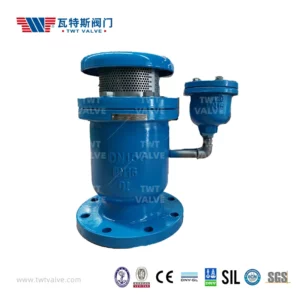Proportional flow control double orifice air valves regulate air flow based on input signals from sensors or controllers by adjusting the size of the valve openings in response to changes in the input signals.
Here’s how they work:
- Input Signal: Proportional flow control valves receive input signals from sensors or controllers that measure the desired flow rate, pressure, or other relevant parameters in the pneumatic system. These input signals provide feedback on the system’s operating conditions and performance.
- Actuation Mechanism: The valve is equipped with an actuation mechanism, such as a pneumatic or electric actuator, that controls the position of the valve openings. The actuator responds to the input signals from the sensors or controllers by adjusting the valve openings accordingly.
- Dual Orifice Design: Proportional flow control valves feature a dual orifice design with two separate flow paths or orifices. By adjusting the size of these orifices independently, the valve can regulate the flow of air entering or exiting the pneumatic system with precision.
- Control Algorithm: The input signals from the sensors or controllers are processed by a control algorithm within the valve or external control system. This algorithm determines the required adjustments to the valve openings based on the desired flow rate or pressure setpoints and the current system conditions.
- Valve Adjustment: In response to the input signals and control algorithm, the actuator adjusts the position of the valve openings to achieve the desired flow rate or pressure within the pneumatic system. The proportional flow control valve continuously modulates the size of the orifices to maintain the setpoint and respond to changes in the system’s operating conditions.
- Feedback Loop: Proportional flow control valves may incorporate a feedback loop to monitor the actual flow rate or pressure within the pneumatic system. double orifices air vavle Feedback signals from sensors or transmitters provide real-time information on the system’s performance, allowing the valve to make rapid adjustments to maintain optimal conditions.
- Closed-Loop Control: Some proportional flow control valves operate in a closed-loop control mode, where the input signals are continuously compared to the feedback signals to ensure accurate and precise control over the flow rate or pressure. This closed-loop control mechanism helps minimize deviations from the setpoint and maintain stable system operation.
- Integration with Control Systems: Proportional flow control valves can be integrated into pneumatic control systems using standard communication protocols such as analog signals (e.g., 4-20 mA) or digital interfaces (e.g., Modbus or Profibus). This allows for seamless communication between the valves and other components of the control system, enabling coordinated operation and centralized control.
Overall, proportional flow control double orifice air valves regulate air flow based on input signals from sensors or controllers by adjusting the size of the valve openings in response to changes in the system’s operating conditions. Through precise control and modulation of the flow rate, these valves help maintain optimal performance and efficiency in pneumatic systems.
